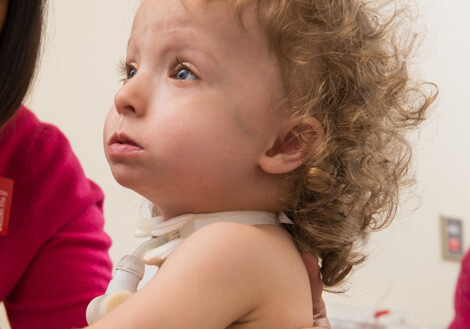Throat and Airway

Throat and Airway

Conditions we treat
Airway problems (breathing problems)
- Difficulty breathing through mouth or nose.
- Chronic nasal congestion.
- History of having a tracheotomy tube.
- History of needing ventilator support during infancy and early childhood.
- Recurrent croup.
- Noisy breathing (stridor or stertor).
Airway obstruction
- History of choking.
- Chronic coughing.
- History of prematurity requiring intubation (breathing tube in throat).
- Barky cough or recurrent croup.
- Turning blue or need to call 911 due to problems with breathing.
Chronic aspiration and drooling
- Cough always present.
- Worse congestion or cough after eating or drinking.
Congenital and acquired conditions
- Babies who are born with a problem that affects their throat and airway
- Children who have developed a problem that affects their throat and airway or had an injury to the area.
- Laryngeal and tracheal malformations.
Gastroesophageal reflux disease (GERD) and Laryngopharyngeal reflux (LPR)
Gastroesophageal reflux disease, often referred to as GERD, occurs when acid from the stomach backs up into the esophagus. Normally, food travels from the mouth, down through the esophagus and into the stomach. A ring of muscle at the bottom of the esophagus, the lower esophageal sphincter (LES), contracts to keep the acidic contents of the stomach from refluxing or coming back up into the esophagus. In those who have GERD, the LES does not close properly, allowing acid and other contents of the digestive tract to move up - to reflux - the esophagus.
Symptoms may include problems with hoarseness, high-pitched noisy breathing and wet voice.
Laryngopharyngeal reflux (LPR) describes a type of GERD in which the contents of the stomach and upper digestive tract may reflux all the way up the esophagus and into the back of the throat. Symptoms can include hoarseness, difficulty swallowing, and difficulty with the sensation of drainage from the back of the nose.
In infants and children, LPR may cause breathing problems such as cough, hoarseness, stridor (noisy breathing), croup, asthma, sleep-disordered breathing, feeding difficulty (spitting up), turning blue, pauses in breathing (apnea), apparent life-threatening event (ALTE), and even a severe deficiency in growth.
Salivary gland diseases
The major salivary glands secrete saliva into the mouth. Besides these glands, there are many minor salivary glands located in your lips, inner cheek area (buccal mucosa), and throughout the other linings of your mouth and throat.
Salivary glands produce the saliva used to moisten your mouth, initiate digestion, and help protect your teeth from decay. As a good health measure, it is important to drink lots of liquids daily. Salivary glands can get infected, become swollen or may produce stones that cause pain with eating.
Sleep disordered breathing
Symptoms of sleep-disordered breathing include:
- Snoring.
- Trouble breathing during sleep.
- Pauses in breathing during sleep.
- Struggling to breathe.
- Restless and poor sleep.
- Poor school performance along with snoring.
- Any medical conditions that contribute to sleep issues.
The JAWS Clinic at Children's Mercy helps children with jaw, airway and sleep difficulties. The clinic allows families to see several different types of specialists in one visit.
Tongue-tie
Tongue-tie is the non-medical term for a relatively common physical condition that limits the use of the tongue - ankyloglossia. Before we are born, a strong cord of tissue that guides development of mouth structures is positioned in the center of the mouth. It is called a frenulum. After birth, the lingual frenulum continues to guide the position of incoming teeth. As we grow, it recedes and thins. In some children, the frenulum is especially tight or fails to recede and may cause tongue mobility problems.
Voice and resonance disorders
Symptoms may include a nasal tone in the voice, hoarseness or a 'breathy' voice. The nasal tone in the voice can be due to incomplete closure of the soft palate muscle in the mouth during speech, called velopharyngeal insufficiency.
Hoarseness is the voice quality produced when something interferes with the normal vibration of the vocal folds and can be caused by nodules, polyps, cysts, or other growths on the vocal folds. Abnormal movement of the vocal folds can also cause voice changes.
Children's Mercy offers the Velopharyngeal Dysfunction (VPD) Clinic for children with voice difficulties related to the physical structure of their mouth and throat.
Tonsil and adenoid diseases
Tonsil and adenoid disease is a broad term that can include many familiar diagnoses such as tonsillitis or strep throat, adenoiditis and sleep disordered breathing.
Tonsillitis refers to inflammation of the pharyngeal tonsils (glands at the back of the throat, visible through the mouth). The inflammation may involve other areas of the back of the throat, including the adenoids and the lingual tonsils (tonsil tissue at the back of the tongue).
There are several variations of tonsillitis: acute, recurrent, and chronic tonsillitis and peritonsillar abscess. Viral or bacterial infections and immunologic factors lead to tonsillitis and its complications.
Nearly all children in the United States experience at least one episode of tonsillitis, and surgical removal of the tonsils is common. Watch the video to learn about what to expect after a tonsillectomy surgery.
Tonsillectomy After Care Booklet
This booklet includes information on what to expect after tonsillectomy surgery, including tips for helping your child take medication and instructions for when to call the doctor if you have concerns.
Download the Guide
